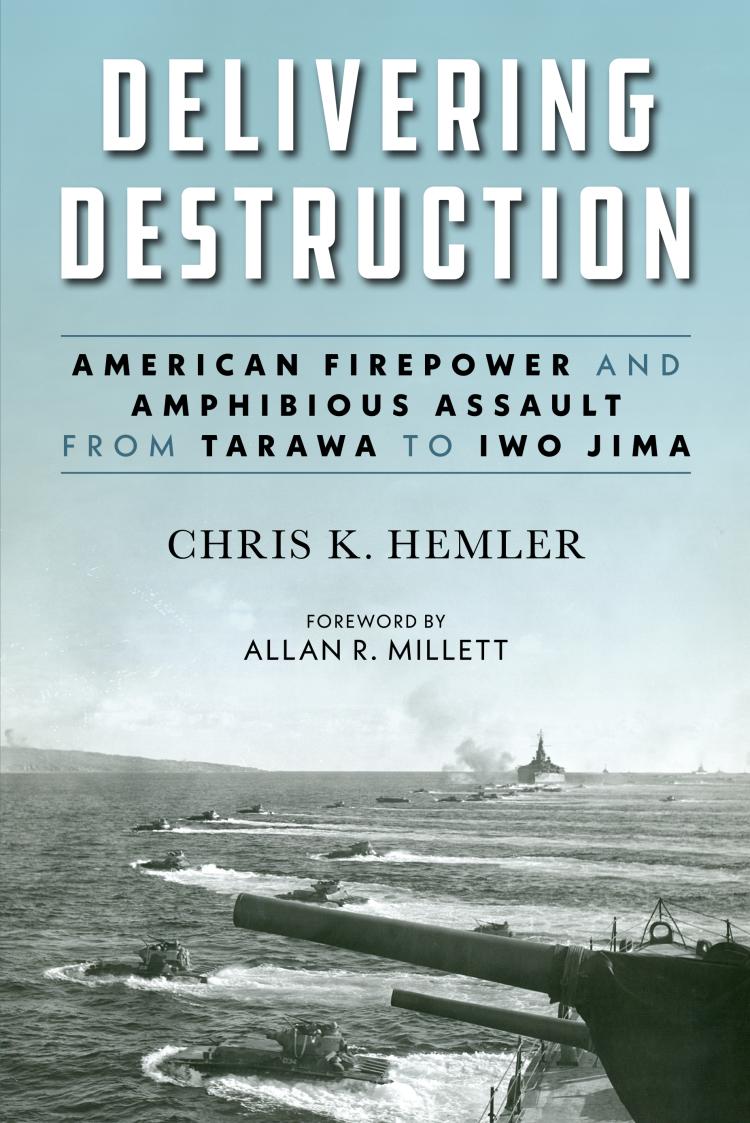Delivering Destruction
- Subject: Fall 2023 Catalog | Strategy | World War II | Society of Military History Conference
- Format:
Hardcover
- Pages:
256pages
- Illustrations:
16 b/w photos; 4 maps
- Published:
October 15, 2023
- ISBN-10:
1682471349
- ISBN-13:
9781682471340
- Product Dimensions:
9 × 6 × 1 in
- Product Weight:
17 oz
Overview
Existing literature maintains that the U.S. Marine Corps’ operational success in the Pacific War rested upon two dominant themes: committed theoretical preparation and courageous battlefield action. Put simply, the Marines wrestled with the conceptual challenges of the amphibious assault in the 1920s and 1930s, then developed the tools and methods necessary to seize a hostile beach. When Japanese forces attacked Pearl Harbor in 1941, the Corps sent its brave and spirited infantrymen to advance across the enemy-held islands of the South and Central Pacific. But the full story runs much deeper. Though this conventional narrative captures essential elements of the U.S. Navy and Marine Corps' triumph, it fails to account for substantial interwar deficiencies in fire control and coordination, as well as the critical wartime evolution of those capabilities between 1942 and 1945.
Delivering Destruction: American Firepower and the Amphibious Assault from Tarawa to Iwo Jima is the first detailed study of American triphibious (land, sea, and air) firepower coordination in the Pacific War. In describing the Amphibious Corps' development of fire-coordination teams and tactics in the Central Pacific, Hemler underlines the importance of wartime adaptation, battlefield coordination, and the primacy of the human element in naval combat. He reveals the untold story of American fire control and coordination teams in the Central Pacific. Through “bottom-up” adaptation and innovation, American troops and officers worked out practical solutions in the field, learning to effectively apply and integrate air and naval support during a contested amphibious assault. The Americans' ability to mount tremendous, synchronized firepower at the beachhead—a capability established through three years of grueling wartime transformation—allowed the U.S. Navy and Marine Corps to seize any fortified Japanese island of its choice by 1945. Despite advancing technology and expanding “domains” of warfare, combat remains a deeply interactive, human endeavor.
About the Author
Editorial Reviews
“Chris Hemler’s focused study on the critical role of fire support, from both ships and aircraft, during the amphibious campaigns of the Pacific War 1943-45, shows clearly how integration, coordination, and especially communication, are essential to effective combined arms operations.” —Craig L. Symonds, author of Nimitz at War: Command Leadership from Pearl Harbor to Tokyo Bay
“Hemler has written a brilliant account of a critical aspect of amphibious assault operations: the delivery, coordination, and integration of fires during the most difficult of military operations. This is a piece of the history of developing the ability to project power ashore against a hostile beach that has not received the attention and analysis that it deserved. Chris's excellent research and superb writing makes this a must read for all who study and enjoy military history.” —Gen. Anthony C. Zinni, USMC (Ret.)
“Delivering Destruction brilliantly describes the importance of the human element in warfare. As his account makes clear, nowhere is the human element more important than in the detailed fire support coordination required for amphibious operations. The lessons described in this book remain deeply relevant as we prepare for conflict in this same region. Although the technologies and methods of combined arms have changed dramatically, the vital role of the human element remains constant. Chris’ work helps us learn from the past as we look to the next fight in the Pacific.” —Col. J. P. McDonough, 89th Commandant of Midshipmen, U.S. Naval Academy
"Chris Hemler is the latest scholar to demolish the simplistic notion that the Allies won World War II mainly due to massive material advantages. Hemler shows us that the effective use of naval gunfire support was not simply a matter of applying brute force, but was instead—much like Allied victory itself—the product of determination, innovation, and excellent teamwork. Highly recommended."
—John C. McManus, Ph.D., Curators' Distinguished Professor, Missouri University of Science and Technology, author of Fire and Fortitude, Island Infernos, and To the End of the Earth
“A must read! Extensively researched, lucidly written, and vitally important for those planning future Indo-Pacific operations, Delivering Destruction is destined to become the definitive study of how Marines, Sailors, Soldiers, and pilots made ‘triphibious’ warfare work in World War II.” —Bryon Greenwald, National Defense University and author of The Anatomy of Change
The great Prussian theorist of war Carl von Clausewitz wrote: “Everything is very simple in war, but the simplest thing is difficult. These difficulties accumulate and produce a friction [that] . . . distinguishes real war from war on paper.” Chris Hemler, a historian who spent ten years on active duty in the U.S. Marine Corps, approaches his study of the use of “triphibious” warfare in the Central Pacific campaign of World War II, Delivering Destruction, with a Clausewitzian mindset that enriches our understanding of how U.S. naval and Marine forces achieved victories from Tarawa to Iwo Jima.—New York Journal of Books
"Aside from the Inchon amphibious operation during the Korean War, nothing remotely like the Pacific amphibious assaults has occurred since. However, one contemporary issue looms above all others – the People’s Republic of China’s determination to regain Taiwan ‘by force if necessary’. Strategic and military analysts are canvassing ranges of scenarios in countering such a contingency. While technologies and tactics have changed exponentially since 1945, the lessons learnt in the Pacific War of joint planning and coordination are still relevant. As such, Delivering Destruction is a timely reminder of the complexities of amphibious operations and is worthy of study by planners and operators at all levels of the joint domain."—Australian Naval Institute




